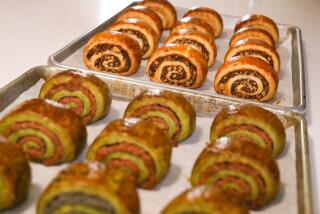Holiday baking with spices
Blame it on the nutmeg. Of course it’s a holiday staple, a sprinkling grated over eggnog, half a teaspoon for mulled cider, a quarter teaspoon in a pumpkin pie. But when a recipe calls for grating one and a half whole nutmegs, well, that’s a lot of nutmeg, and the next thing you know I’m making panforte and grating away with my Microplane to see just how much (after a five-minute elbow workout, it yields a small handful). In the meantime, the piles of spices are accumulating on the kitchen counter -- cinnamon, cloves, black pepper, coriander -- and it all smells so Zanzibar-fantastic.
Now’s the time to raid the spice rack and get baking: gingerbread, German cookies such as pfeffernüsse,speculaas or springerle, and panforte, the dense, spicy confection that’s available in every bakery in Italy during the holidays but is nearly impossible to find here, or nearly impossible to find a very good one, anyway.
And if the only spice route you have traveled lately is the baking aisle of the supermarket, then you might be missing out on a spice renaissance that has driven trends on restaurant menus (i.e. za’tar, berber, vadouvan) and exalts hand-harvested vanilla beans, organic allspice, sun-dried cloves, woody Egyptian coriander, Chinese black cardamom (sweeter than the Indian variety), or angelica seeds from Marais Poitevin, France.
You’ll find musky Hungarian moula and zesty, peppery grains of paradise from Ghana by going to the website L’Epicerie ( www.lepicerie.com). Le Sanctuaire (www.le-sanctuaire.com) has pungent white Muntok peppercorns from owner Jing Tio’s farms in Indonesia. Spice guru Aaron Isaacson (known to his New York chef clientele as Mr. Recipe and occasionally Mr. Vanilla) says that pastry chefs lately have been enamored with ground, powdered Madagascar vanilla beans and sumac, the tangy Middle Eastern spice that has been showing up, daringly, in cakes and pies.
Spice entrepôt Penzeys ( www.penzeys.com) -- there’s one in Torrance and one planned for Santa Monica -- carries Grenadian mace, East and West Indian nutmeg, and four types of cinnamon: Ceylon, China Cassia, Korintje Cassia and Vietnamese.
There are few recipes that make a more profligate use of these spices than panforte, essentially dried and candied fruits and nuts mixed with aromatic spices, and just a little bit of flour to hold it all together. The translation is “strong bread,” a reference to the pungency of the spices in a dessert that dates to 13th century Siena.
My favorite panforte recipe -- the one that inspired that industrious nutmeg grating -- is from “Tartine” by Elisabeth Prueitt and Chad Robertson, owners of Tartine Bakery in San Francisco. It is heady stuff: a small mountain of nutmeg, plus the cinnamon, pepper, cloves, coriander, and a cup of cocoa for not so much a chocolate note as an earthy underpinning.
And there’s plenty of room for variation. A recipe from David Lebovitz’s “Room for Dessert” calls for a pinch of chile pepper, which is an excellent idea. Alice Medrich’s recipe from her book “Pure Dessert” includes fennel seeds, white pepper and ginger.
The Tartine panforte I made is one of the best I’ve tasted, a deeply spicy cross between cake and confection (leaning more toward confection). I cut thick wedges of it, wrapped them in parchment, tied them with string and gave them away as gifts.
But I can’t think of an easier, more whimsical way to fill the house with the sugar-and-spice aromas of the holidays than to bake gingerbread cookies. They’re fragrant with cinnamon, black pepper, cloves, cardamom and allspice, supported by brown sugar and molasses -- a sweet-caramely-earthy complement to all the spices.
A dedicated cookie baker with a highly wrought sense of aesthetics might try his hand at German springerle -- the Christmas cookies of Swabia. They’re more delicately flavored than other spice cookies, hitting all the notes of just one spice: fennel. The pale, embossed cookies are formed with beautiful wood or ceramic molds to create patterns such as snowflakes, acorns, Santas or the “little knights” after which they’re named.
Once the cookies are embossed and cut, the dough is allowed to dry for 24 hours, and the flavors of anise extract and anise seeds ripen.
Experimentation with a centuries-old cookie recipe is not unwarranted. Instead of anise, try Saigon cinnamon or Costa Rican cardamom. Or nutmeg; a little elbow exercise to work off some holiday calories might be welcome.
Hallock is a Times staff writer.
More to Read
Sign up for our L.A. Times Plants newsletter
At the start of each month, get a roundup of upcoming plant-related activities and events in Southern California, along with links to tips and articles you may have missed.
You may occasionally receive promotional content from the Los Angeles Times.







